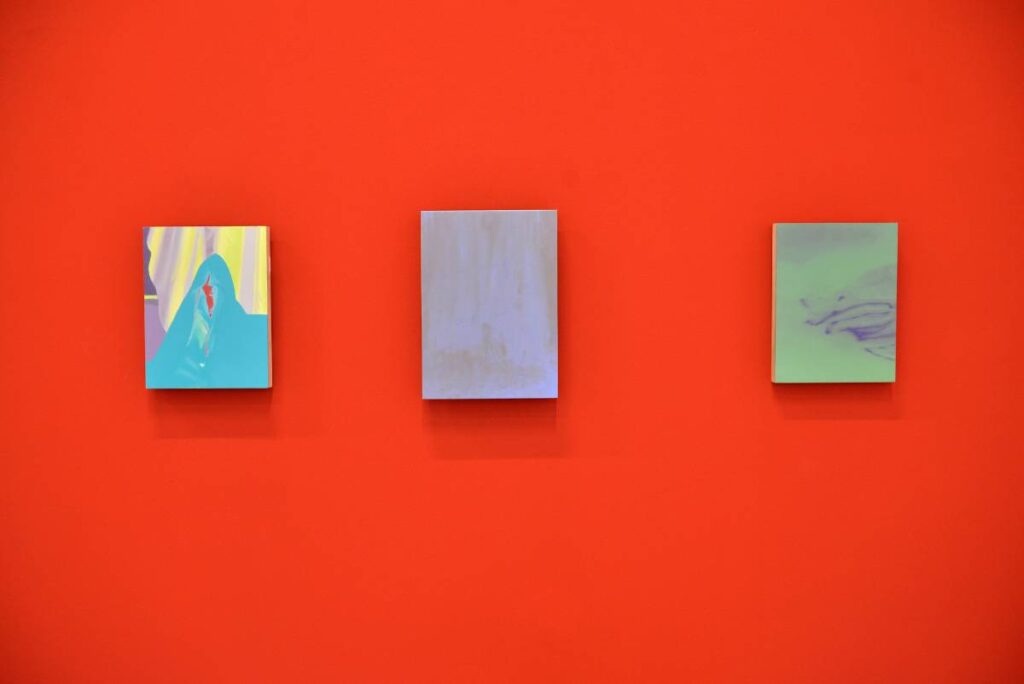Personal Metonymies
02 January – 02 March 2018
Artist: Marcel Rusu
Location: Sector 1 Gallery
Marcel Rusu’s exhibition at Sector 1 Gallery is an elegant reminder that there is an intimate connection between image and memory, an attempt of making its viewers aware of the evocative power of the former and of the eerily fleeting character of the latter. Memory, death and images have been strongly linked since the beginning of picture production, as figurative imagery fundamentally attempts to achieve an implausible -symbolic or even magic- victory over death and oblivion. As noted by art historian Hans Belting, images live from the paradox that they perform the presence of an absence and vice versa. What is being depicted is never actually here, in front of us: images are spatially and temporally removed avatars of the body, the person or the landscape that they bring into presence. In the case of art imagery, where expressive intent and aesthetic awareness are involved, the picture is the end result of a process during which, by deploying various visual technologies, the artist attempts to endow the image with a life of its own, to make the symbolic and emotional traces of the “real thing” emerge into (ghostly) existence.
These dialectic and tensed relations between presence and absence, as well as between memory and loss, are crucial for Rusu’s works featured in Personal Metonymies. They obliquely, yet acutely make an attentive observer aware of the concomitantly banal and remarkable fact that pictures cannot escape thier fundamental function of mediating between, ultimately, life and death. His paintings and transferred photographic images spectacularly use the visual logic of the fragmentary and the alteration: manipulating images by such means, they end up alluding, at the same time, to the transience of human existence, to the inescapability of death, to the fragility of memories and also to the affectionate ways in which we attempt cherish them.
In the paintings displayed in Personal Metonymies show, the artist recurrently uses figurative devices meant to partially hide or to blur the represented fragments of reality, such as curtains, veils or strange chromatic filtering. These figurative means deserve particular hermeneutic attention, as they perform various and important, symbolic and emotional, operations. The curtains -either placed in forefront or in the background- both obscure and reveal; every time they appear in the emphatically static painterly images of the artist, one can never tell whether they are being lifted of lowered. Reminding of Baroque rhetoric, they serve the purpose of both framing the image and pointing out its artificiality.
Secondly, there are the veils. Hiding, totally or partially, the identity of the depicted characters, they both frustrate one’s curiosity and fuel one’s fantasy. The cultural significance of the veil encompasses a broad spectrum, which stretches from signalling the realm of the sacred to restoring dignity to the dead. Rusu’s paintings vividly appropriate their ritualistic value and use them almost as props by means of which the psychanalytical assertion that mourning and melancholia are but two side of the same coin is epitomized.
Finally, there is the use of chromatic filters and alterations of the “original”, photographic image, which constitutes the starting point of the art work. They present a paradox of their own, for a painting cannot actually be blurred or “chromatically altered”. These technical interventions or unintentional effects properly pertain to the realm of photography. The painting assumes them in an intentional manner, instituting a tensed dialogue between mental images, their photographic counterpart and their painterly avatar. The latter is remote in the third degree from the memory that is being remembered, yet becomes all the more evocative as its artificiality is emphatically pointed out.
Imitation of photographical effects in paintings usually fall under the category of the Pop Art related photorealism, which mainly addressed topics like original vs. copy or the dynamics of consumerism. However, in Rusu’s paintings, nothing could be more deceiving than their Pop look, as his flavour of Realism is not photorealism, but rather traumatic realism: his images don’t deal in a critique of consumerism, but rather attempt to sketch a visual phenomenology of memory, loss and mourning. The “metallic” tones make the figures appear both acutely unnatural and stridently present, while the muted, greyish filtering transmutes them into the realm of the spectral. Thus, like masks, they gain the ability of signifying an absent entity, while forcefully signalling its very absence.
All in all, in Marcel Rusu’s strangely spectacular paintings, personal memories, family photos and holyday snapshots are turned into subtle memento mori, which fascinate by means of tension between sensuousness and a particular feeling of transience. His recent art does not lack displays of technical skilfulness, yet ultimately relies of an overall soft, melancholic elegance. Collapsing together allusions to mourning and bursts of chromatic hysteria, he produces arresting work that seems to mainly aim at reminding the viewer that, at the end of the day, we are what we remember.
Bogdan Iacob
In the paintings displayed in Personal Metonymies show, the artist recurrently uses figurative devices meant to partially hide or to blur the represented fragments of reality, such as curtains, veils or strange chromatic filtering. These figurative means deserve particular hermeneutic attention, as they perform various and important, symbolic and emotional, operations. The curtains -either placed in forefront or in the background- both obscure and reveal; every time they appear in the emphatically static painterly images of the artist, one can never tell whether they are being lifted of lowered. Reminding of Baroque rhetoric, they serve the purpose of both framing the image and pointing out its artificiality.
Secondly, there are the veils. Hiding, totally or partially, the identity of the depicted characters, they both frustrate one’s curiosity and fuel one’s fantasy. The cultural significance of the veil encompasses a broad spectrum, which stretches from signalling the realm of the sacred to restoring dignity to the dead. Rusu’s paintings vividly appropriate their ritualistic value and use them almost as props by means of which the psychanalytical assertion that mourning and melancholia are but two side of the same coin is epitomized.
Finally, there is the use of chromatic filters and alterations of the “original”, photographic image, which constitutes the starting point of the art work. They present a paradox of their own, for a painting cannot actually be blurred or “chromatically altered”. These technical interventions or unintentional effects properly pertain to the realm of photography. The painting assumes them in an intentional manner, instituting a tensed dialogue between mental images, their photographic counterpart and their painterly avatar. The latter is remote in the third degree from the memory that is being remembered, yet becomes all the more evocative as its artificiality is emphatically pointed out.
Imitation of photographical effects in paintings usually fall under the category of the Pop Art related photorealism, which mainly addressed topics like original vs. copy or the dynamics of consumerism. However, in Rusu’s paintings, nothing could be more deceiving than their Pop look, as his flavour of Realism is not photorealism, but rather traumatic realism: his images don’t deal in a critique of consumerism, but rather attempt to sketch a visual phenomenology of memory, loss and mourning. The “metallic” tones make the figures appear both acutely unnatural and stridently present, while the muted, greyish filtering transmutes them into the realm of the spectral. Thus, like masks, they gain the ability of signifying an absent entity, while forcefully signalling its very absence.
All in all, in Marcel Rusu’s strangely spectacular paintings, personal memories, family photos and holyday snapshots are turned into subtle memento mori, which fascinate by means of tension between sensuousness and a particular feeling of transience. His recent art does not lack displays of technical skilfulness, yet ultimately relies of an overall soft, melancholic elegance. Collapsing together allusions to mourning and bursts of chromatic hysteria, he produces arresting work that seems to mainly aim at reminding the viewer that, at the end of the day, we are what we remember.
Bogdan Iacob
Looking for more?
Address
Băiculești 29 Street, District 1, 013193, Bucharest, Romania
Opening Hours
Tuesday – Saturday, 2 – 7 PM
Sunday – Monday, by appointment only
Newsletter
Sign up to receive the latest news on the gallery’s artists
Sector 1 Gallery © 2023. All Rights Reserved.
Privacy Policy

